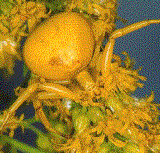Araneae
Spiders


The Araneae are the true spiders. Unlike the fossil spider-like trigonotarbids and their allies, almost all spiders have only five segments in the abdomen, and these are generally fused with no external trace of segmentation -- the earliest spiders had as many as twelve segments in their abdomen.
The last two abdominal segments are specially modified into spinnerets which secrete the silk threads for which spiders have become well known. There are one to four pairs of spinnerets present, even on those spiders which do not spin webs. The silk has many other functions, such as in sperm transfer, encasing the eggs, and building nests or burrows. Those spiders which do use their silk for webs often produce complex and intricate patterns, but complex or not, the web's function is the capture of prey.
 Other spiders which do not spin webs will stalk or ambush their prey. Wolf
spiders, tarantulas, and jumping spiders are of this sort. Some species
are brightly colored, and hide within flowers where they are camouflaged,
waiting to pounce on visiting insects. A very few of these are large enough
to capture small birds. These spiders rely on their amazing speed and
paralyzing poison to subdue their captures.
Other spiders which do not spin webs will stalk or ambush their prey. Wolf
spiders, tarantulas, and jumping spiders are of this sort. Some species
are brightly colored, and hide within flowers where they are camouflaged,
waiting to pounce on visiting insects. A very few of these are large enough
to capture small birds. These spiders rely on their amazing speed and
paralyzing poison to subdue their captures.
The front pair of appendages, the chelicerae, are the ones which contain the poison glands. The second pair, the pedipalps, are small, and are used by the male during mating. The head bears four pairs of eyes, the arrangement of which can be very useful for the identification of the several different kinds of spider. Most spiders breathe through tracheae; some, like the wolf spiders, have both book lungs and tracheae.
As with other arachnids, there is an abundance of fossils in the mid-Paleozoic and the later part of the Cenozoic. However, there are no known spiders from the Mesozoic, a gap in the record of 200 million years.
For more on the phylogeny of spiders, visit the Araneae pages at the Tree of Life, maintained at the University of Arizona.
Spider photographs are available from the Arachnid Mailing List -- also with links to other spider pages. Also check out the guide to the jumping spiders (Salticidae) of America north of Mexico for information on one of the larger families of spiders.

Petrunkevitch, A. 1960. Arachnida. P42-P162 in Moore, R.C. (ed.) Treatise on Invertebrate Paleontology. Part P: Arthropoda 2: Chelicerata. Geological Society of America and University of Kansas Press, Lawrence, Kansas.

